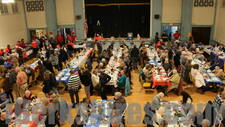NARH Teams with Mass. General Hospital for Stroke ServicesBy Susan Bush
12:00AM / Thursday, June 09, 2005
 | | Video monitors, laptop computers, and remote control cameras are the tools of a NARH/Mass. General Hospital telemedicine link. |
North Adams – For those stricken with an ischemic stroke, the magic number is three; intravenous administration of tPA, a blood-clot busting drug, must occur within three hours after the stroke commences and a timely, accurate diagnosis is critical to the proper use of the drug. When given appropriately, tPA can reduce the effects of an ischemic stroke and decrease permanent stroke-related disability.
Real Time, Real Benefits, Real Lives
Time-saving diagnostic responses are now available at the North Adams Regional Hospital, courtesy of a new telemedicine system that connects Emergency Department physicians and nurses with neurologists at the Massachusetts General Hospital.
The communication between hospitals is in real time, and so far, the result has been positive. In May, two patients were evaluated and treated based on the video-audio conferencing capability.
On June 9, a live technology demonstration occurred at NARH, and media members were able to observe the system in action.

NARH Director of Emergency Medicine Dr. Paul Donovan |
Dr. Lee Schwamm, director of acute stroke services at the Massachusetts General Hospital and NARH Director of Emergency Medicine Dr. Paul Donovan enlisted a volunteer “patient†to simulate a consultation. From his post in Boston, Schwamm was able to see and speak with Donovan, the patient, and others in the room. In an actual stroke situation, a MGH doctor would be able to speak with any family members present, which can aid with the patient evaluation. Communication with a MGH neurologist is possible at all hours, every day.
During the demonstration, Donovan provided Schwamm with pertinent information including the patient age and symptoms. Schwamm asked the “patient†to perform certain physical tasks, such as raising and extending the arms, rapid hand-clapping and noted that he could see the response. By speaking with the “patient,†Schwamm could detect any drooping at the mouth, notice any slurred speech, and was able to use a video device for close-up views of the head and appendages. He was also able to converse easily with others in the room; in an actual emergency situation, a physician or nurse would be with the patient and immediately accessible to a MGH neurologist.
The importance of a correct and rapid diagnosis cannot be overstated, Schwamm said.
“What we say is ‘time is brain,’†he said.
Critical Care at Critical Moments
tPA [tissue plasminogen activator] is not the recommended treatment for all strokes, which means that determining that the event is ischemic, meaning caused by a blood clot, is extremely critical. The time factor underscores the need for prompt assessment, and the telemedicine system allows MGH physicians to review a patient’s brain scan and other tests, assess the patient through visual and verbal contact, and consult with NARH medical personnel in an on-the-spot fashion.
The conferencing capability can expedite decisions about whether tPA is recommended, and if so, the medicine can be delivered without unnecessary delay. The system can also benefit patients affected by other types of stroke, such as hemorrhagic [bleeding] stroke, by ruling out ischemic stroke. tPA is not recommended for strokes caused by conditions other than blood clots.
Prior to system implementation, patients affected by possible strokes would likely have been stabilized, telephone conferences may have occurred, but without the advantages of the telemedicine service, in many cases patients were transferred to other hospitals for evaluation via Lifeflight services. NARH is able to utilize local neurologist services, however, an area neurologist is not always available. The process could devour precious minutes, and the three-hour window could, in some cases, be closed.
NARH President Dr. Bruce Nash attended a live telemedicine demonstration on June 9. |
Saving Time = Saving $$$
Time is not only brain, but money. According to Schwamm, every patient successfully treated with tPA saves about $4,000 in medical costs, and the savings may be even greater because of reduced disability and continuing care expenses. According to information available at the MGH Web site, 794 individuals per 100,000 have had a stroke, and 80 percent of all strokes are ischemic.
The North Adams Hospital was recently designated as a stroke treatment center by the state Department of Public Health. About a dozen state-based hospitals are linked to the stroke services system; the Franklin Medical Center in Greenfield is currently the closest facility to NARH using the system.
The MGH stroke services system is also used internationally, and Massachusetts is the first state to offer the services on a wide-scale basis. Schwamm said that in the U.S., several entities are using or implementing telemedicine networks on a smaller scale.
Wave of the Future
Telemedicine has tremendous potential to impact other medical arenas and the technology is expected to expand and grow, Schwamm said. Medical specialties such as dermatology, pathology, especially in the area of oncology, and psychiatry are utilizing the technology, he noted.
“This is the wave of the future and will hopefully become the wave of the present,†he said.
Stroke Symptoms
Stroke symptoms may include sudden weakness or numbness of the face, arm, or leg, which most often affects one side of the body, sudden confusion, difficulty speaking or comprehending others who are speaking, difficulty seeing that affects one or both eyes, sudden difficulty with walking, loss of balance, dizziness, and an abrupt onset headache with no apparent cause. Stroke symptoms may vary and symptoms depend on which side of the brain is involved, which portion of the brain is affected, and the severity of any damage. Symptoms may differ from person to person. Anyone who believes they are experiencing a stroke should seek medical assistance immediately.
Risk factors for stroke include smoking, high blood pressure, high blood cholesterol levels, obesity and a sedentary lifestyle. Age, gender, and family history may also play a role in assessing stroke risk.
Susan Bush may be reached at 802-823-9367 or by e-mail at suebush123@adelphia.net. |





















